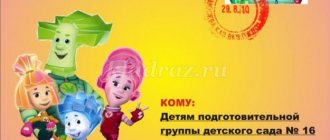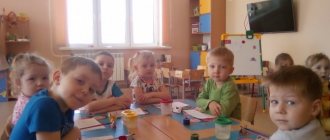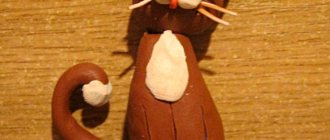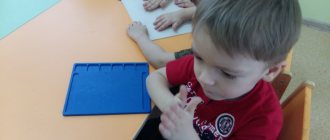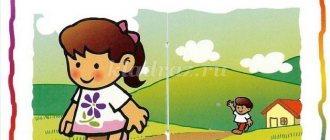Preparatory viewing:
"Municipal economical preschool institution
kindergarten No. 9, Balakovo"
Music lesson notes
in the 2nd junior group
"Introduction to musical instruments."
- Training tasks:
- distinguish the timbres of musical instruments;
- distinguish the character of a piece of music, make the appropriate movements;
- develop vocal abilities, start singing after the introduction, sing harmoniously in an ensemble, correctly pronounce the words of songs.
- develop the ability to play children's musical instruments;
- Developmental tasks:
- develop sensory sensitivity,
- sensory capabilities and pitch hearing,
- develop a sense of rhythm and fine motor skills.
- form vocal voice and expressiveness of movements.
- Educational tasks:
- foster a love and enthusiasm for music;
Material for the lesson
- screen
- 3 toys (bird, rabbit, horse) and, accordingly, musical instruments (triangle, tambourine, wooden spoons).
Music manager. Hello guys! Do you understand what “Hello” means? This word comes from the word “Health” - “Health”. What should you do to be healthy?
Music manager. Let us, too, in order to stay awake, create a little exercise for now.
Valeological chant song with health massage “Good morning” (lyrics and music about Arsenevskaya)
1. Good morning! spread their arms to the sides and smile a little faster! bow to each other And now the whole day is “springy” It will be more fun. raise their hands up
2. We stroke the forehead, make movements according to the text Nosy and cheeks. We will be beautiful, tilting our heads to the right and left, Like flowers in the garden! shoulder alternately Let's rub our palms movements according to the text Stronger, stronger! Now let’s clap “Bolder, bolder!” We'll rub your ears now and save your health. Let's smile again, Be healthy everyone! spread their arms to the sides
Music manager. Guys, we have guests now. In order for them to appear, you need to guess riddles (Riddles about a bird, a rabbit, a horse).
The kids solve riddles, and the music manager points out the toys.
Our guests waited a long time and got a little tired. You need to take it off to play and show the movements. What is the bird doing?
Music manager. How can we show?
Kids. Just run on your toes.
Music manager. What about the rabbit?
Music manager. Horse?
Kids. Straight gallop.
Music manager. And each movement has its own music, and for now I will play, but listen closely, the music will give you a hint which movement needs to be performed.
Music sounds for easy running, jumping, straight galloping (at the discretion of the music director), and the kids make the appropriate movements.
Oh, we danced so funny and got a little tired. Let's sit down, relax, and go to the chairs.
Music manager. Guys, our guests have not come empty-handed. Each guest has his own favorite musical instrument, and you will understand which one when you recognize this instrument by its sound.
He goes behind the screen and plays the instruments: Bird – triangle, Rabbit – tambourine, Horse – wooden spoons.
Music manager. And for now we will listen to music, and you will tell me what its mood is.
We sit quietly and prepare our ears, Because we want to learn to listen.
The music manager performs the melody of the Russian folk song “Oh, you, canopy.” The kids are talking.
Music manager. What can you do with it?
Music manager. The music is dancing, joyful, playful. Guys, you probably saw that the music did not always sound identical.
Music manager. That’s right, I played sometimes quietly, sometimes loudly. For now we will take musical instruments and play the way the music sounds.
Kids play musical instruments.
Music manager. Well done! Do you and I also have a musical instrument - is this our voice? What do we do with our voice?
Music manager. Naturally. But in order to sing beautifully and not harm your voice, you first need to warm up your voice. We will sing a musical warm-up, be careful, sing without clicking, listen to the music and to each other.
“Musical warm-up” (music and lyrics by E. Makshantseva, arranged by L. Kalbus)
Music manager. Great, warm up your voice, and find out what song I’m going to play for you at the moment.
Kids name a familiar song based on the intro.
Music manager. Right. Let's all sing together.
Song “Sparrow” (music by V. Gerchik, lyrics by A. Cheltsov)
And at the moment, a joyful game awaits you, children. One, two, three, four, 5 We need to quickly get into a circle.
Game “Have Fun Kids” (Estonian folk song arranged by T. Popatenko, Russian text by I. Chernitskaya)
Music manager. Well done boys! And now I invite you to a breathtaking forest. Get up in a line, let's follow me like a train.
A set of preventive exercises for the upper respiratory tract (O. Arsenevskaya) The exercises can be accompanied by showing illustrations or slides.
The locomotive brought us to the forest. Chug-chug-chug! Chug-chug-chug! (walking around the hall with arms bent at the elbows) It’s full of miracles. (say “mm-mm” in surprise as you exhale, immediately tapping your fingers on the wings of your nose) Here comes the angry hedgehog: P-f-f-f, p-f-f-f, p-f-f-f! (bend a little low, clasping his chest with his hands - a hedgehog curled up into a ball) Where is the nose? You won't get it. F-f-r! F-f-r! F-f-r! Here is a joyful bee who brought honey to the children. Zzzz! Z-z-z! (direct sound and gaze according to the text) She sat on our elbow, Zzzz! Zzzz! Flew onto my toes. Zzzz! Zzzz! The donkey scared the wasp: Y-ah! Y-ah-ah! Y-ah-ah! (strengthening the throat ligaments, preventing snoring) He shouted to the whole forest: Y-ah! Y-ah-ah! Y-ah-ah! Geese are flying across the sky, Geese are buzzing to the donkey: G-oo-oo! G-u-u! G-u-u! G-u-u! G-u-u! G-u-u! G-u-u! G-u-u! (slowly walking, raising your wing arms as you inhale, lowering them with a sound) Tired? You need to rest, sit down and yawn sweetly.
Kids sit on the carpet and yawn a couple of times, thereby stimulating the laryngopharyngeal apparatus and brain activity.
Music manager. Have you rested? Now you can go for a walk. Our lesson has come to an end, let's say goodbye.
Summary of a music lesson for children of the 2nd junior group.
Tatyana Koval Summary of a music lesson for children of the 2nd junior group
Summary of a music lesson for children of the 2nd junior group.
Continue teaching children to listen closely to an adult’s singing and instrumental music. Answer questions about the content and character of the music. Teach kids to sing in a sonorous voice. Make movements as shown by the teacher and hear the end of the music. To develop the ability to convey the main emotions and feelings through facial expressions, posture, gestures, and movements. Cultivate a desire to perform in front of children and adults. Cultivate a sense of friendship.
Objectives: To teach speech, vocal, motor abilities.
Equipment: Box, rattles, bird toy, cat toy, dog toy.
Synopsis of a musical lesson TEAR AND HIS FAVORITE TOYS
The summary of the music lesson in the kindergarten was compiled by Zoya Vladimirovna Sheshukova, music director of the highest qualification category of the MBDOU “Combined Kindergarten No. 17”, Glazov. The lesson is held for children of the first junior group.
Tasks:
1. Educational: (artistic and aesthetic development, cognitive development)
- introduce to melodious, drawn-out, expressive singing;
- learn to move in accordance with the pronounced character of the music, connect movements with music;
- introduce children to the changes in the lives of animals in the spring season;
- Encourage children to answer independently.
2. Developmental: (artistic and aesthetic development, speech development)
- promote active manifestations of children in the process of listening and performing activities;
- develop emotional responsiveness to music, its character and mood, to the musical image accessible to the child.
3. Educational: (socio-communicative development)
- cultivate a friendly attitude towards each other, towards Mishutka, and careful attitude towards toys;
- encourage children to want to please each other;
- fostering independence in actions with objects.
Repertoire:
- Dance “Ribbons”, music by G. Vikhareva.
- “Dance with Flags”, music by G. Vikhareva.
- "Playful dance with bears."
- Song "Sun", music by A. Filippenko.
- Playing with a bell, music by E. Grinina.
- Communication game “Horse”, music by E. Makshantsev.
Equipment and aids:
- laptop,
- multimedia projector,
- screen (interactive whiteboard);
- bells,
- checkboxes,
- teddy bear toys,
- ribbons,
- Containers for attributes (for each child) are located under the chairs.
Literature:
- Vikhareva G.F. Song, ring! Toolkit. – St. Petersburg: “Childhood-press”, 1999. – 48 p.
- “Bell” No. 54/2013 educational, methodological, literary and musical magazine - St. Petersburg.
- Makshantseva E.D. Children's fun. – M.: Education, 1991. – 64 p.
- Petrova V.A. Reader for the “Baby” program for children of the 3rd year of life. Part 1.: Moscow 2000.
Summary of a music lesson for children of the first junior group BEAR AND HIS FAVORITE TOYS
Music sounds, children calmly enter the hall.
Musical director: - Hello, guys! Today the Sun came to visit us!
Slide 1.
Musical director: - Guys, let's say together “Hello, Sunny!”
Children say hello to Sunny.
Musical director: - Sunny really likes the way you sing. What song can we sing for him?
Children's answers.
Song "Sun", music by A. Filippenko.
Musical director: - Sunny, did you like how the guys sang for you? Well done guys, you all worked really hard - Sunny really enjoyed it!
Slide 2.
Educator: - Out of joy, the sun’s rays became multi-colored, like our ribbons. They invite us to dance.
Children take ribbons and stand in a circle.
“Dance with Ribbons”, music by G. Vikhareva.
Educator: - How fun we danced! Let's put the rays in baskets so they don't run away.
Children put ribbons in baskets - containers.
Slide 3.
Musical director (draws attention to the screen): - Look, guys, who is sleeping so sweetly?
Children: - Bear!
Musical director: - Where does he sleep?
Children: - In the den.
Musical director: - And when will he wake up?
Educator: - It’s already spring! It's time to wake up Mishenka.
Musical director: - Let's take our ringing bells and wake up Mishka.
Playing with bells, music by E. Grinina.
Slide 4.
Educator: - So Mishutka woke up! Let's say hello to Mishka.
Children greet Mishutka.
Educator: - Mishutka slept well, rested and is very glad that we came to visit him. Mishutka loves to play. Show me, Mishutka, what your favorite toys are.
Slides 5, 6, 7 depicting various toys.
Educator: - Bear asks us to guess which toys he likes to play with the most.
Slide 8.
Further, the repertoire during the lesson will be performed in any order. Children choose “Mishutka’s favorite toy” if they wish. If they guess right, the toy remains on the screen and is enlarged. If the choice is incorrect, the toy disappears.
Educator: - What beautiful balls! Where can you guys go with balloons?
Children's answers.
Educator: - Don’t we have balloons that we can take with us to the holiday?
Children's answers.
Educator: - That's right, flags. Look, Mishutka, how joyfully we walk with them!
“Dance with Flags”, music by G. Vikhareva.
Educator: - Come on, Mishutka, we’ll still try to guess your favorite toy. Look, guys, Mishutka loves to play with the bear cub! Let's show Mishutka how to dance with the cubs.
"Playful dance with bears."
Educator: - Mishutka invites us to guess another favorite toy. Who is this, guys? That's right, Horse! What interesting toys Mishutka has! Thank you, Mishutka, for showing us your favorite toys, come and visit us. We will also show you our favorite toys. Goodbye!
The children say goodbye to Mishutka.
Educator: - And you and I will harness the horses and go back to kindergarten!
Communication game “Horse”, music by E. Makshantseva.
Musical director: - Guys, did you enjoy visiting Mishutka? What are his favorite toys? What toys did you play with?
Educator: - Probably, our toys in the group got bored without us. Let's get back to them soon!
Slide 9.
The children say goodbye and leave the hall to calm music.
Perhaps the last toy will not be a horse, in which case the teacher will, at his own discretion, sum up the lesson.
Author: Natalya Borisovna Sokolova, music director
Institution: MBDOU of the city of Kostroma “Kindergarten No. 52” Locality: Kostroma
Program content: Type of musical activity: GCD (standard lesson).
Goals: To develop the musical and creative abilities of children in various types of musical activities, using modern, gaming and health-saving technologies.
Objectives: 1. Educational: - strengthening children’s motor skills with musical accompaniment; - introduce the breathing exercise “Ay!”, - introduce the finger gymnastics “Bird”; - to form the basics of singing skills, start singing after the introduction, sing harmoniously in an ensemble, coordinate hand movements with singing, clearly sing the words of the song, continuing to learn the song “Little Bird” lyrics. E. Makshantseva, music. A. Filippenko; — to develop the ability to independently engage in musical and rhythmic movements, breathing and finger exercises, and singing. 2. Developmental: - to develop singing skills; - develop fine motor skills of the hands; — develop children’s attention during musical play; - develop cognitive interests, creative activity and initiative. 3. Educational: - promote the development of a careful attitude towards one’s health; — create conditions that ensure the emotional well-being of each child; - evoke an emotional response from the actions taken; — increase the adaptive capabilities of the child’s body through musical and rhythmic movements, breathing exercises, finger play, singing, emotional well-being and other health-saving technologies. Attributes: toy bird on a clothespin, tree, toy dog. Repertoire: - entrance to the hall “The Sun is Shining” music. A. Ermolova, lyrics. V. Orlova; - valeological chant song “Good morning” by muses. etc. O. N. Arsenevskaya; - literary words (riddles); — music by E. Tilicheeva (Ladushki junior group No. 10); — music by E. Tilicheeva (Ladushki Jr. group No. 81); - music - rhythm exercise, “Birds fly and peck grains.” Swiss folk melody. (Ladushki junior group No. 21); - perception. "Sounds of nature. Birdsong" phonogram; — finger gymnastics “Bird”; — breathing exercises “Ay!”; - singing “Little Bird” lyrics. E. Makshantseva, music. A. Filippenko; - dance “Spring Dance” lyrics. and music L. Olifirova; — musical game “Here the birds flew” by E. Zheleznov; - song game “Dog Barbos” by S. G. Nasaulenko (performed by the teacher).
Progress of the lesson:
View lesson notes in full...
You can download materials for informational purposes only, all
The rights to the materials on the site belong to their authors.
